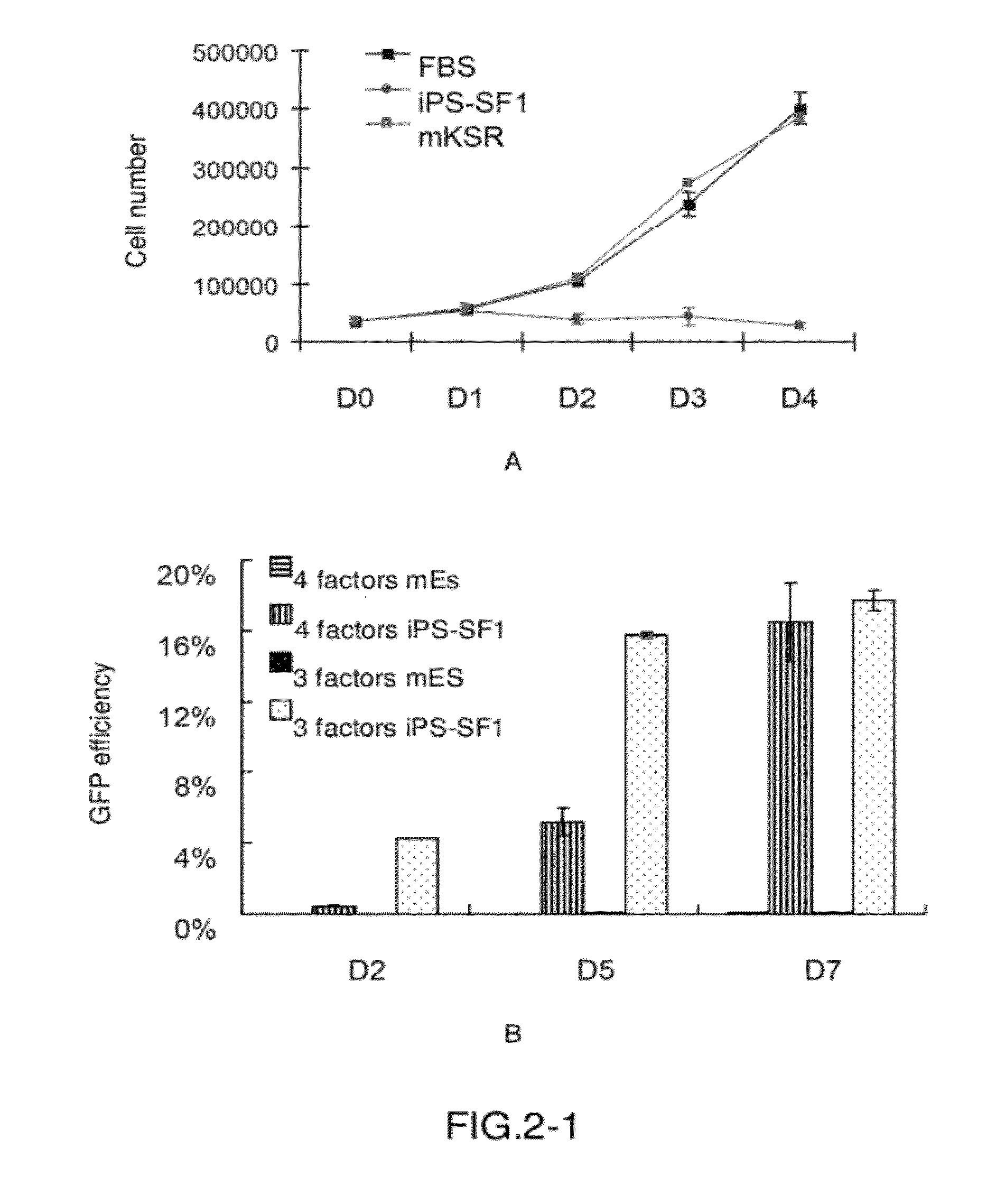Serum-free medium for inducing pluripotent stem cells quickly with high efficiency and method using thereof
a technology of serum-free medium and pluripotent stem cells, which is applied in the field of serum-free medium for inducing pluripotent stem cells quickly with high efficiency, can solve the problems of low efficiency of establishing hes cell lines, difficult to obtain donor oocyte sources, and high consumption of human oocytes, and achieves high efficiency
- Summary
- Abstract
- Description
- Claims
- Application Information
AI Technical Summary
Benefits of technology
Problems solved by technology
Method used
Image
Examples
example 1
[0076]The traditional mKSR medium cannot maintain the growth of MEF cells transfected with the four factors, and meanwhile cannot induce the formation of iPS cells.
[0077]As described above, the viruses of the four factors were mixed in 1:1:1:1 (1 mL each) and then infected into totally 35,000 fibroblasts in one well of a six-well plate and cultured in mKSR medium and mES medium respectively at 37° C. with 5% CO2.
[0078]As shown in FIG. 1, the fibroblasts transfected with the four factors and cultured in mKSR grew slowly and still did not form colony morphology of pluripotent cells, indicating that mKSR medium cannot induce and generate iPS colonies.
example 2
Use of iPS-SF1 Medium can Greatly Increase the Efficiency of Inducing iPS Cells
[0079]A. MEF cells were cultured in FBS medium and iPS-SF1 medium respectively. The growth curves thereof are almost identical, indicating that iPS-SF1 has no effect on MEF cell culture. In contrast, the growth of MEF cells substantially stopped in mKSR (FIG. 2A).
[0080]After three factors (Oct4, Klf4, and Sox2) or four factors (cMyc, Oct4, Klf4, and Sox2) were transfected into fibroblasts, the transfected cells were cultured in iPS-SF1 medium respectively and the efficiency of GFP positive cells was measured as described above at days 2, 5, and 7 after transfection. It was observed that all cells, whether being transfected with the four factors or the three factors, exhibited high efficiency (FIG. 2B) and even reached an efficiency of 18% at day 7. Thus, this is a great improvement as compared to traditional methods (mES control as shown).
[0081]Accordingly, in this process, direct observation using a fluo...
example 3
iPS Cells Induced by iPS-SF1 Possess Pluripotency
[0083]A. The cell morphology of the iPS cell line obtained through induction is similar to that of the embryonic stem cell.
[0084]As described above, fibroblasts were infected with the three factors and then cultured in iPS-SF1 medium all the time. At days 12-14 after infection, representative clone clumps were picked up based on clone morphology and fluorescence expression, and uniform iPS cell lines were formed after several generations of stable passage.
[0085]As shown in FIG. 2A, the left panel shows normal embryonic stem cells and the right panel shows the iPS cell lines described above. These cell lines are very similar to embryonic stem cells in morphology and strongly express the green fluorescence of Oct4-GFP.
[0086]B. The formation of chimeric mice confirms that the iPS cell lines obtained through induction possess pluripotency.
[0087]Construction of Chimeric Mice
[0088]Blastulas for injection were taken from four-week-old supero...
PUM
 Login to View More
Login to View More Abstract
Description
Claims
Application Information
 Login to View More
Login to View More - R&D
- Intellectual Property
- Life Sciences
- Materials
- Tech Scout
- Unparalleled Data Quality
- Higher Quality Content
- 60% Fewer Hallucinations
Browse by: Latest US Patents, China's latest patents, Technical Efficacy Thesaurus, Application Domain, Technology Topic, Popular Technical Reports.
© 2025 PatSnap. All rights reserved.Legal|Privacy policy|Modern Slavery Act Transparency Statement|Sitemap|About US| Contact US: help@patsnap.com



